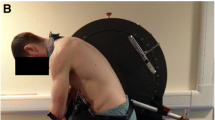Abstract
We measured the effects of lumbar discectomy on segmental motion over a period of 5 years. Twenty-four patients with lumbar disc herniation were treated by standard lumbar discectomy at the L4–L5 or L5–S1 level. Peroperatively, tantalum markers were inserted into L4, L5, and the sacrum. Radiostereometric analysis was performed at discharge from hospital and 5 years postoperatively. The treated level was compared with the corresponding untreated level. Thus, patients who had discectomy at the L4–L5 level served as controls for patients with L5–S1 lesions and vice versa. The relative rotation and translation in relation to the three cardinal axes were calculated. Inducible displacements over the two discs were calculated between the supine and standing positions. At the L4–L5 level, there were no differences in inducible displacements between the operated and control levels at discharge or 5 years postoperatively. At the L5–S1 level we found decreasing inducible movement in the sagittal plane over time for discectomy patients. The reason for decreasing mobility over time after discectomy at the L5–S1 but not at the L4–L5 level is unknown. Mechanical factors caused by the more vertical orientation of the L5–S1 disc in combination with degenerative changes could be one explanation.
Résumé
Nous avons mesuré les effets de la discectomie lombaire sur la mobilité segmentaire sur une période de 5 années. Vingt-quatre malades avec une hernie discale lombaire ont été opérés par discectomie standard au niveau L4–L5 ou L5–S1. Des marqueurs en tantale ont été insérés en peropératoire dans L4, L5 et le sacrum. L’analyse radiostéréométrique a été exécutée à la sortie de l’hopital et 5 ans après l’intervention. Le niveau opéré a été comparé avec le niveau non-opéré correspondant. Donc, les malades opérés sur L4–L5 ont servi comme contrôles pour malades opérés sur L5–S1 et vice versa. La rotation et la translation relatives selon les trois axes cardinaux ont été calculées. Les déplacements induits sur les deux disques ont été calculés entre les positions debout et couché sur le dos. Sur L4/L5 il n’y avait pas de différences dans les déplacements induits entre les opérés et le contrôle initial ou 5 ans aprés. Sur L5/S1 nous avons trouvé avec le temps des mouvements induits décroissants dans le plan sagittal pour les malades opérés. La raison de la mobilité décroissante avec le temps après discectomie L5–S1 mais pas au niveau L4–L5 est inconnue. Les facteurs mécaniques en relation avec l’orientation plus verticale du disque L5–S1, en association avec l’évolution dégénérative pourraient être une explication.
Similar content being viewed by others
References
Börlin N, Thien T, Kärrholm J (2002) The precision of radiostereometric measurements. Manual vs. digital measurements. J Biomech 35:69–79
Frobin W, Brinckmann P, Biggemann M, Tillotson M, Burton K (1997) Precision measurement of disc height, vertebral height and sagittal plane displacement from lateral radiographic views of the lumbar spine. Clin Biomech (Bristol, Avon) 12 (Suppl 1):S1–S63
Frobin W, Brinckmann P, Leivseth G, Biggemann M, Reikerås O (1996) Precision measurement of segmental motion from flexion–extension radiographs of the lumbar spine. Clin Biomech (Bristol, Avon) 11:457–465
Goel VK, Goyal S, Clark C, Nishiyama K, Nye T (1985) Kinematics of the whole lumbar spine. Effect of discectomy. Spine 10:543–554
Johnsson R, Selvik G, Strömqvist B, Sundén G (1990) Mobility of the lower lumbar spine after posterolateral fusion determined by roentgen stereophotogrammetric analysis. Spine 15:347–350
Kelsey JL, White AA III (1980) Epidemiology and impact of low-back pain. Spine 5:133–142
Kirkaldy-Willis WH, Farfan HF (1982) Instability of the lumbar spine. Clin Ortop 110–123
Kärrholm J (1989) Roentgen stereophotogrammetry. Review of orthopedic applications. Acta Orthop Scand 60:491–503
Leivseth G, Brinckmann P, Frobin W, Johnsson R, Strömqvist B (1998) Assessment of sagittal plane segmental motion in the lumbar spine. A comparison between distortion-compensated and stereophotogrammetric roentgen analysis. Spine 23:2648–2655
Lu WW, Luk KD, Ruan DK, Fei ZQ, Leong JC (1999) Stability of the whole lumbar spine after multilevel fenestration and discectomy. Spine 24:1277–1282
Nachemson A (1966) The load on lumbar disks in different positions of the body. Clin Ortop 45:107–122
Nilsson KG, Kärrholm J, Ekelund L (1990) Knee motion in total knee arthroplasty. A roentgen stereophotogrammetric analysis of the kinematics of the Tricon-M knee prosthesis. Clin Ortop 147–161
Stokes IA, Medlicott PA et al (1980) Measurement of movement in painful intervertebral joints. Med Biol Eng Comput 18(5):694–700
Tibrewal SB, Pearcy MJ, Portek I, Spivey J (1985) A prospective study of lumbar spinal movements before and after discectomy using biplanar radiography. Correlation of clinical and radiographic findings. Spine 10:455–460
Willén J, Danielson B, Gaulitz A, Niklason T, Schönström N, Hansson T (1997) Dynamic effects on the lumbar spinal canal: axially loaded CT-myelography and MRI in patients with sciatica and/or neurogenic claudication. Spine 22:2968–2976
Vitzthum HE, König A, Seifert V (2000) Dynamic examination of the lumbar spine by using vertical, open magnetic resonance imaging. J Neurosurg 93:58–64
Acknowledgements
The authors acknowledge technical support by Ulla Grangård and Birgitta Runze, RSA lab. This work was supported by grants from the Göteborg Medical Society, the Greta and Einar Askers Foundation, and the Doktor Félix Neubergh and Arne och Ingabritt Lundberg Foundation.
Author information
Authors and Affiliations
Corresponding author
Rights and permissions
About this article
Cite this article
Halldin, K., Zoëga, B., Nyberg, P. et al. The effect of standard lumbar discectomy on segmental motion: 5-year follow-up using radiostereometry. International Orthopaedics (SICOT) 29, 83–87 (2005). https://doi.org/10.1007/s00264-005-0636-8
Received:
Accepted:
Published:
Issue Date:
DOI: https://doi.org/10.1007/s00264-005-0636-8




